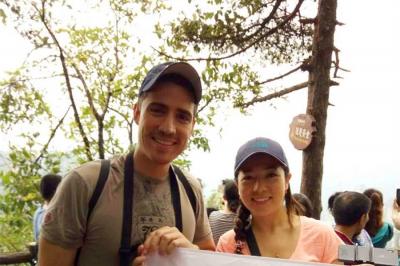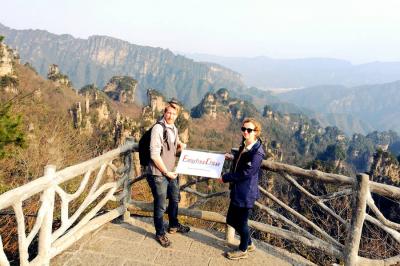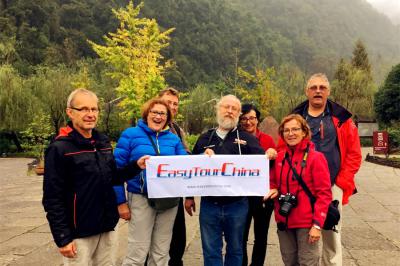Fenghuang Ancient Town
Fenghuang means phoenix in Chinese. In Chinese culture, the male one is called Feng, and the female called Huang. According to the legend, some phoenixes flew over this small city and were so absorbed by its beauty, so they were reluctant to leave and stay here permanently, hence, the name - Phoenix Ancient Town or Fenghuang Ancient Town.
Located in the west of Hunan province, Fenghuang consists of 9 towns, 22 counties and 344 administrative villages. The old city wall was first built around 1704 with east and north gates still erected. The peaceful Tuo River flows across the small town, you can see quite a number of wooden cabins were built half suspended over the river, people usually call them ‘Diaojiaolou’.
Fenghuang Ancient Town is the home to minority ethnic groups, mainly Miao and Tujia nationalities. The batik and tie-dye are very popular among the minorities here. Miao and Tujia have their own ways to produce the cloth with unique folk patterns. Beside, they also make embroidery (Tujia), silverware (miao) and paper cut. The gingier candy is also a well-known specialty in Fenghuang Ancient City.
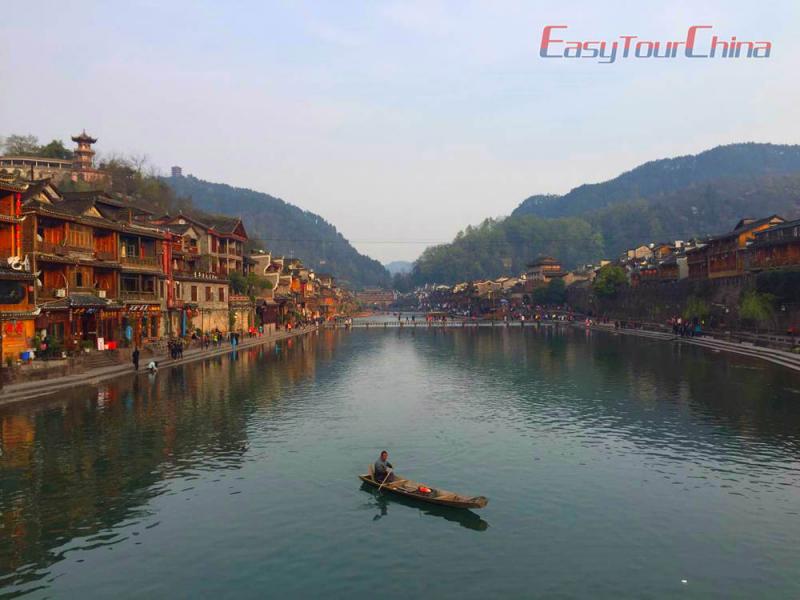
Hunan Fenghuang Ancient Town Facts
- The core nine scenic spots of Fenghuang Ancient Town: RMB128 yuan (including Shen Congwen's Former Residence, boating on the Tuojiang River, Wanshou Palace, Xiong Xiling's Former Residence, Yang Family Ancestral Hall, Hongqiao, Chongde Hall, Ancient Town Museum, and Dongmen City Tower)
- Night cruise on the Tuo River: RMB80 yuan
The History
Located at the junction of the Wuling Mountains and the Yunnan-Guizhou Plateau, Fenghuang Ancient Town is a major gateway connecting the Central Plains with the minority regions in the southwest by virtue of the Tuojiang River waterway and the Xiangqian Ancient Road. The history of the ancient city of Fenghuang dates back to the Spring and Autumn Period and the Warring States Period.
In the Tang Dynasty, Weiyang County was established here, and in the Yuan Dynasty, it was upgraded to Wuzhai Si. In the 31st year of the Ming Dynasty (1552), the city was changed from an earth city to a brick city, garrisoned with troops and fields, forming an important node in the defense system of the “Miaojiang Great Wall” (the Great Wall in South China). During the Ming Dynasty, Fenghuang Ancient City was under the jurisdiction of the Tusi system. The Tusi system was a form of local government established in minority areas during the Yuan, Ming and Qing dynasties, with minority leaders acting as “Tusi” (Chieftain) to manage local affairs.
In the 43rd year of the reign of Emperor Kangxi of the Qing Dynasty (1704), the Phoenix Camp was established. After the implementation of the policy of "replacing local chieftains with appointed officials" during the reign of Emperor Yongzheng, Han culture accelerated its infiltration, eventually shaping a unique form of integration between Han culture and Miao culture.
>> Recommended 6-day Zhangjiajie Tour to Fenghuang Ancient Town
Best Time to Visit Fenghuang Ancient Town, China
Fenghuang has distinct four seasons and mild temperature, with average annual temperature 15.9℃ and average annual rainfall 1308mm. The hottest July is around 24-27℃, and the coldest January is around 1.7-4.3℃ (average). In general, the four seasons of the year can be regarded as the best time for Fenghuang Old Town tour. If you are a photography enthusiast, the best time to visit Fenghuang Ancient Town are around March 1st, April 15th, Sep 10th and Nov 20th every year. The effects of taking picture of Fenghuang Ancient City are the best during this time, with beautiful scenery and good light.
What to See and Do in Fenghuang Ancient Town
This small town was praised as the most beautiful town in China by the famous New Zealand writer Louis Ailey. Fenghuang Ancient Town is adjacent to Dehang Miao village in Jishou, Mengdong River in Yongshun and Fenjing Mountain in Guizhou, the traffic is very convenient. >> Explore 8 “Best Tourism Villages” in China Listed by UNWTO
Fenghuang Ancient City has beautiful scenery, the major attractions in Fenghuang includes cruise at Tuo River, East Gate of Fenghuang, the Residence of Mr. Shen Cong-wen, Southern Great Wall built in Ming Dynasty and Qiliang Cave. Besides, the small town gives birth to several celebrities, such as, the famous writer - Sheng Cong-wen and the painter-Huang Yongyu.
Fenghuang Ancient City has 68 ancient buildings, 116 ancient ruins, more than 120 characteristic residences of the Ming and Qing Dynasties, and more than 30 temples, shrines and pavilions of various kinds, making it the county with the largest number of existing cultural relics and buildings in Southwest China.
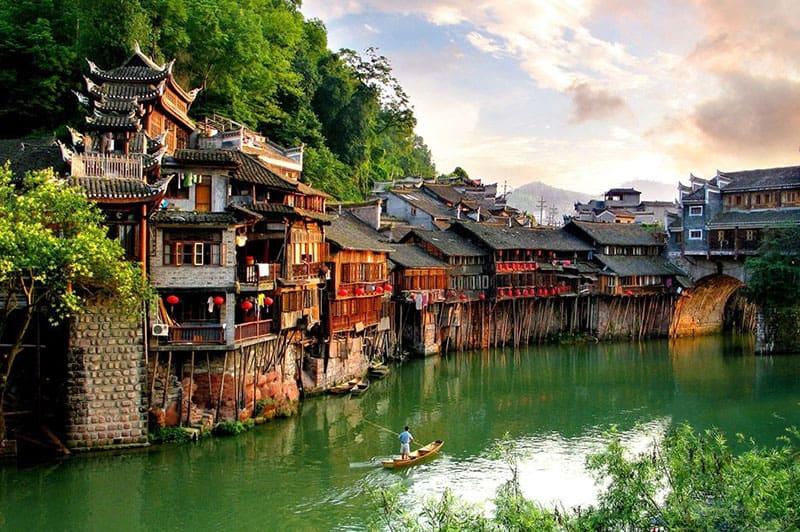
Tuojiang River
Tuojiang River is the mother river of Fenghuang, it flows slowly according to the city wall and feeds the generations of the ancient town. Listening to boatman’s song on Wupeng boat and admiring the stilted buildings (Diaojiao Lou) on both side of Tuojiang River, which has really special charms. The ancient city wall on the south bank of Tuojiang River is made of purple red sandstone, it looks elegant and majestic. There are two towers in the east and north of the city wall, which are still magnificent after many vicissitudes of life. The water of Tuojiang River is clear and the flow is gentle, you can see the water plants swaying with the waves in the river, which can support a long pole.
Enjoying the Tuojiang River boat ride, going downstream and crossing the Hongqiao Bridge, a picture of a water town unfolds before your eyes: Wanshou Palace, Wanming Pagoda, Duocui Tower.
Tuojiang stilted building
Located in the southeast of the ancient city, with the ancient official road in front and the Tuojiang River in the back, the stilted building group is one of the ancient buildings with strong Miao architectural characteristics in Fenghuang ancient town. With a total length of 240 meters, it is a building of the Qing Dynasty and the early Republic of China, and there are more than ten families are living in it now. Stilted building is a unique architectural of Miao ethnic group, which has high aesthetic value and cultural relic research value.
>> Related reading: The Most Distinctive Traditional Dwellings in China
Hong Bridge
Hong Bridge located on the Tuojiang River, it is one of the famous scenic spots in Fenghuang ancient city. Completed in 1670, the bridge is 112 meters long, 8 meters wide and 10.2 meters high, with a load capacity of 80 tons. The bridge was built by vermilion sand and stone, when it was completed, it was like a rainbow lying on the river, hence the name Hong Bridge (Hong means rainbow in Chinese).
On both sides of the bridge road, there were 12 stilted wooden houses, restaurants and department stores, and a 2-meter-wide pedestrian corridor in the middle. There is a roof above the corridor to avoid wind and rain, so it is also called wind and rain building. The buildings on the bridge were destroyed during the Cultural Revolution, and were restored in 2000 according to the original design.
Former Residence of Shen Congwen
Shen Congwen is a famous Chinese writer and historian. His former residence was built in 1866, which is a courtyard wood structure building with a history of more than 100 years. This building is divided into front and back sections, with a small patio in the middle and wing rooms on the left and right, which are very exquisite and beautiful. In the exhibition room of his former residence, precious old pictures record Shen Congwen’s hard journey of his life.
Longevity Palace (Wanshougong)
Longevity Palace is located in Shawan of Fenghuang ancient town, with Dongling in the north and Tuojiang River in the front. Wanshou Palace was built in 1755 by Jiangxi people who do business in Fenghuang, it is also called Jiangxi guild hall. In 1854, General Yangsi built Xiachang Pavilion on the west side, and in 1928, Yang Tower was built on the north side of the gate, forming a unique and exquisite architectural community.
Former Residence of Xiong Xiling
Xiong xiling’s former residence is located in an alley of Beiwenxing Street in Fenghuang ancient city, covering a total area of 800 square meters. The former residence is a courtyard wooden tile structure, which is small but very delicate. It is a typical ancient architectural form of the Miao nationality, the four existing houses basically keep their original appearance.
Xiong xiling was such rare talent, he was the fourth premier of the Beiyang government. He was a politician, educator, social activist, industrialist and philanthropist during the period of the Republic of China. Chairman Mao and other revolutionary leaders spoke highly of him.
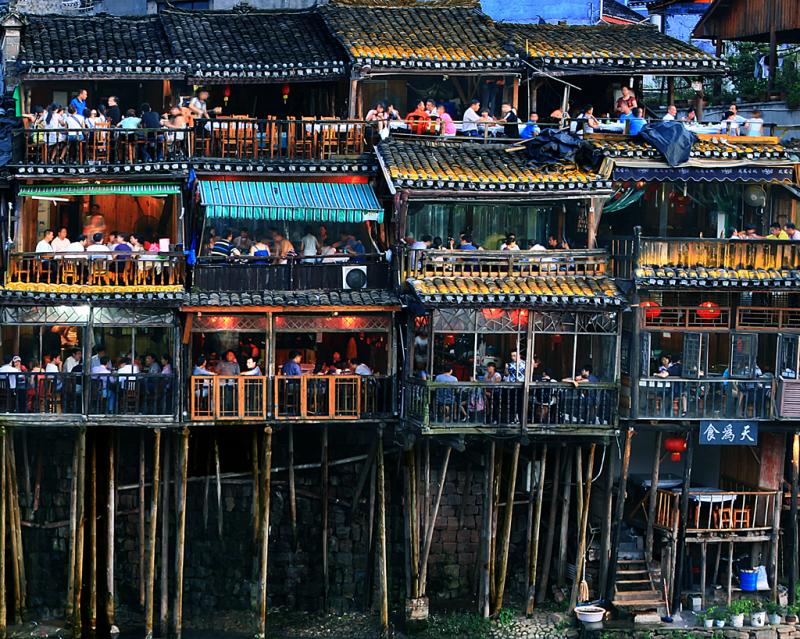
Fenghuang Ancient City Museum
Located at the entrance of Phoenix Ancient City Road, it covers an area of more than 1,600 square meters. The museum is a century-old mansion of the former Chen Baozheng family, where three generations of his family used to live. The museum displays the family's historical and cultural heritage, relics, photographs, pictures, materials, writings and documents donated to the museum by Chen Baozheng's descendants.
North Gate City Tower
The North Gate Tower, also known as the Bihui Gate, is located on the south bank of the Tuo River. It was built together with the ancient city wall in the 50th year of the reign of Emperor Kangxi of the Qing Dynasty (1715). Having endured many vicissitudes, it stands still, together with the North Gate Wharf, forming the landmark buildings of Fenghuang Ancient Town.
The north gate is in the shape of a rectangular arched door opening, 3.4 meters wide and 7 meters deep. The outer height of the door opening is 3.5 meters and the inner height is 4 meters. There are two large iron doors with rivets. Above the gate, there were reliefs of figures and monsters from The Three Kingdoms period, exquisitely carved and vividly lifelike. The city tower is made of brick and tile, with eight gun ports on it. It is integrated with the 6-meter-high city walls on both sides and can defend against enemies and prevent floods.
The tower offers a panoramic view of the Tuojiang River.
>> Recommended 8-Day Beauties of Central China Tour with Fenghuang Old Town
Great Wall of China in the South
Also known as Miaojiang Great Wall and Xiangxi Border Wall, it is a set of military defense system built in western Hunan during the Ming and Qing dynasties, and is a part of the Great Wall of China. The Great Wall of Southern China has 88 sections of wall remaining, 12,944 meters long.
long How to get there? Take a Fenghuang-Ara Town bus from Fenghuang County Tuqiaolong Station for about 20 minutes to arrive at Quanshengying Ying Yingpan.
Fenghuang Old Town Minority Culture
The local Miao people believe in primitive religious forms such as nature worship, totem worship and ancestor worship. In Miao society, people are superstitious about ghosts and gods and witchcraft is prevalent.
Most Miao women in the local area wear short-sleeved shirts with large collars and front lapels, and pleated skirts of various lengths, some reaching the instep and some as short as the knees. Headwear comes in a wide variety of styles. Men's clothing mostly consists of short jackets with large or double lapels, and they wear long pants on the bottom.
The handicrafts in Fenghuang Ancient Town are mainly batik. It is divided into the Tujia batik printed cloth and the Miao batik native cloth schools.
How to Get to Fenghuang Ancient Town
By airplane: If you would like to travel by airplane, the best choice is taking airplane to Tongren Fenghuang Aiprort, which is the nearest one to Fenghuang. The driving time from Tongren Fenghuang airport to Fenghuang Ancient Town is around 2 hours. If there is no flight to Tongren Fenghuang Airport from your city, you could take flight to Changsha or Zhangjiajie airport, while it will takes long time on road.
By train: If you would like to take train for your Fenghuang trip, the best choice is taking high speed train to Huaihua South Station, which is the nearest high speed railway station to Fenghuang Ancient City. You can take high speed train to Huaihua from your city, and then take taxi or bus to Fenghuang Ancient Town, the driving time is about 1 hour. If there is no speed train to Huaihua from your city, you can also take train to Jishou or Zhangjiajie.
From Zhangjiajie to Fenghuang Ancient Town
By bullet train and bus: First, take a bullet train from Zhangjiajie West Railway Station to Jishou Railway Station (about 45 minutes), and then take a bus from Jishou to Fenghuang Ancient Town (about 1 hour).
By bus: Take a non-stop bus from Zhangjiajie Central Bus Station or Wulingyuan Bus Station to Fenghuang Ancient Town, which takes 3.5 to 4 hours.
From Furong Ancient Town to Fenghuang
Take a direct bus from Furong Town Bus Station (1 kilometer outside the scenic area) to Fenghuangcheng North Bus Station, which takes 2 to 2.5 hours. Then, take a taxi for about 10 minutes to reach the ancient city.
What to Eat in Fenghuang Ancient City
The cuisine in Fenghuang Ancient Town is very distinctive. The must-try foods include cold jelly made from mung beans, the century-old Fenghuang ginger candy, Xiangxi specialty blood Cake Duck, traditional Miao sour soup, Fenghuang specialty Miao vegetable tofu, Miao sour radish and Miao rice tofu.
Plan a Trip to Fenghuang Old Town with Easy Tour China
Whether you want to create a Zhangjiajie tour package including Fenghuang Ancient city and or explore only the town, our experts can help customize your ideal holiday. Excellent English-specking local guides and curated collection of hotels are promises. Experience the best of Zhangjiajie and Fenghuang the Easy Tour China way.
